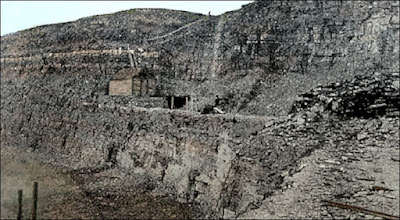Much time has been spent on design and research, but I have managed to start a little construction on the buildings.
You will recall that in a previous post I mentioned having the models reflect the area of the layout by having them built of the appropriate materials for the locale. In this case, stone.
Quite obvious when you think about it. The buildings would be made from materials easily to hand, and that would be the stone from the cliff faces.
I looked for embossed styrene to model the stone walls, but didn’t like what I saw. It all seemed so regular and even. It had got to the stage where I was preparing to scribe my own and hand paint the stones on watercolour paper. But then I took a look at the Clever Models website. I have used their textures before and really like them. They had a sheet on their site called “Illinois Block”. It was O scale and some of the blocks were HUGE. But in G scale they were just big, and that suited me fine. As you can see from this picture, in G scale the stones look quite fine.
 |
| G scale or O scale stones, You decide |
One thing I have settled on is a working tipper, representing the ash from the retort being disposed of. My last endeavors at creating a tipper were none to successful, so I resolved to put some effort into solving the tipping issue. A mock up was built. This little video shows how it works.
Things were progressing well, so I decided to work on a proper structure for the layout, no mock ups. I plumped for the shale oil condenser. A tall structure that will be a centerpiece of the layout. It wasn’t going to be easy. The panels the structure was built of had some interesting pattern in them. Not to mention the hundreds of bolts to used to join the panels together.
 |
| I found this structure quite interesting and knew I had to model it. |
 |
| I like the effect of the panelling. I’m not looking forward to adding all the bolt details. |




















